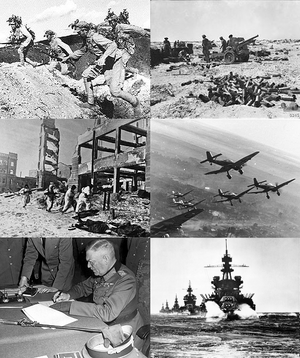World War II/Infobox
| World War II | |||||||
|---|---|---|---|---|---|---|---|
 Clockwise from top left: Chinese forces in the Battle of Wanjialing, Australian 25-pounder guns during the First Battle of El Alamein, German Stuka dive bombers on the Eastern Front winter 1943–1944, US naval force in the Lingayen Gulf, Wilhelm Keitel signing the German Instrument of Surrender, Soviet troops in the Battle of Stalingrad | |||||||
| |||||||
| Belligerents | |||||||
|
Allies Client and puppet states |
Axis Co-belligerents Client and puppet states | ||||||
| Commanders and leaders | |||||||
|
|
Axis leaders | ||||||
| Casualties and losses | |||||||
|
Military dead: Over 16,000,000 Civilian dead: Over 45,000,000 Total dead: Over 61,000,000 (1937–45) ...further details |
Military dead: Over 8,000,000 Civilian dead: Over 4,000,000 Total dead: Over 12,000,000 (1937–45) ...further details | ||||||
| World War II |
|---|
| Navigation |
|
|
References
- Footnotes
- ^ 23 August 1939, the USSR and Germany sign non-aggression pact, secretly dividing Eastern Europe into spheres of influence. USSR armistice with Japan 16 September 1939; invades Poland 17 September 1939; attacks Finland 30 September 1939; forcibly incorporates Baltic States June 1940; takes eastern Romania 4 July 1940. 22 June 1941, USSR is invaded by European Axis; USSR aligns with countries fighting Axis.
- ^ After the fall of the Third Republic in 1940, the de facto government was the Vichy Regime. It conducted pro-Axis policies until November 1942 while remaining formally neutral. The Free French Forces, based out of London, were recognized by all Allies as the official government in September 1944.
